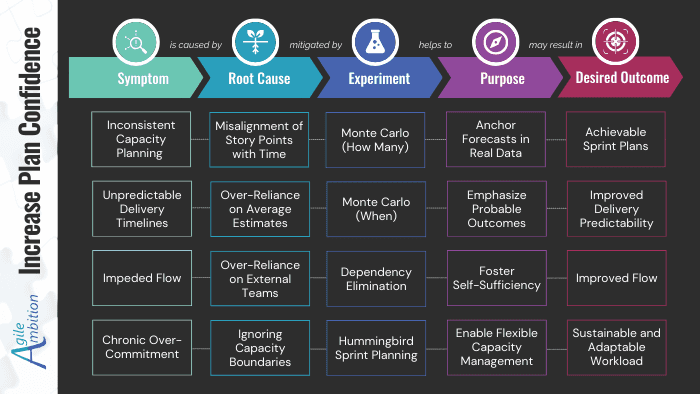Illuminating the Path: Increase Plan Confidence

Overambitious Sprint Plans are like dark roads—hazardous and unpredictable. Illuminate the path to improve clarity and boost confidence in your outcomes.

Do you feel stuck trying to squeeze everything stakeholders want into each Sprint? Pressure to deliver often leads to over-promising and frustration when plans fall short. But what if stakeholders valued transparency over heroic efforts?
In this issue, you’ll explore four experiments designed to help your team create plans they can trust and confidently execute.
From Inconsistent Capacity Planning to Achievable Sprint Plans

Do you rely on story points for estimation, even though they are relative and disconnected from the time-based nature of a Sprint? Estimating in hours seems like a natural alternative, but it’s time-consuming and prone to cognitive bias. Enter Monte Carlo forecasting: by leveraging real historical data tied to actual timeframes, your team can predict how many work items they will likely complete in a Sprint. This approach leads to more realistic and achievable Sprint Plans, reducing guesswork and overcommitment.
Monte Carlo forecasts help your team create achievable Sprint Plans.
🤔 How often does your team struggle to predict what they can realistically achieve in a Sprint?
From Unpredictable Delivery Timelines to Improved Delivery Predictability

Do you use average velocity to predict how many Sprints it will take to finish work? It’s like flipping a coin. “Average” means the team hits this number half the time and misses the rest, yet stakeholders treat it as a promise. Monte Carlo forecasting uses historical data to confidently predict timelines and account for risk without gambling with averages. This method lets you set realistic expectations, communicate probable outcomes, and boost delivery predictability—all without overcommitting your team.
Monte Carlo (When) helps prevent the chaos of overlapping promises and the strain of chasing past “commitments.”
🤔 How could reframing commitments as probabilities improve your team’s workflow and reduce pressure?
From Impeded Flow to Improved Flow

What if, instead of managing dependencies, you focused on eliminating them? What can your team handle tomorrow that depends on others today? Can you pull in cross-functional skills, upskill your team, or build a tool to replace external reliance? Every dependency you cut isn’t just one less roadblock—it boosts your team’s autonomy and flow. Don’t settle for waiting on others; take the reins and clear the path. The fewer dependencies you have, the more control you gain.
Eliminating dependencies empowers your team to work autonomously and reduces delays.
🤔 What’s one dependency your team could eliminate this quarter, and how would it improve your ability to deliver?
From Chronic Over-Commitment to Sustainable and Adaptable Workload

Do you feel pressured to cram everything you’ve been asked for into a Sprint, even though you know it’s unrealistic? A better approach? Focus on the goal. Plan only the work items needed to achieve that goal, and pull in additional tasks only after those are complete. Talk with stakeholders to set expectations—if their item doesn’t align with the goal, it may not make it into the Sprint. This approach shifts extra work from a promise to a “bonus fry,” reducing the risk of perceived failure. Hummingbird Sprint Planning improves focus, builds realistic capacity, and supports sustainable workloads.
Hummingbird Sprint Planning reduces the pressure to overcommit.
🤔 What work in your last Sprint didn’t contribute to the goal, and how could excluding it have improved focus?
TLDR;
Unrealistic Sprint Plans are like driving blind—why risk it? Try these four experiments to plan smarter and deliver with confidence.

Choose one experiment to try this Sprint. Your team will feel the difference.
Share
Table Of Contents
Fuel an Idea
Every week, I break down complex ideas, strip away the fluff, and give you experiments to turn knowledge into skills.
If that’s worth a coffee, consider fueling the next big insight.
No pressure. No guilt trips. Just impact.
Buy Me a CoffeeRelated Posts
Quick Links
Legal Stuff

